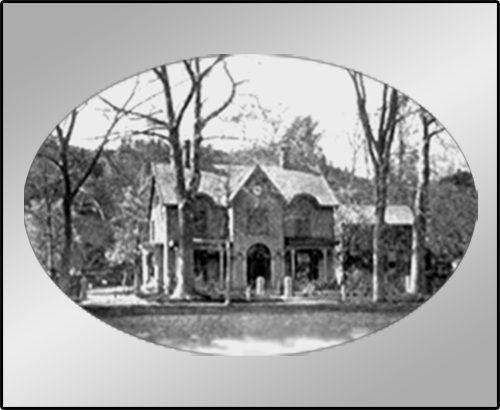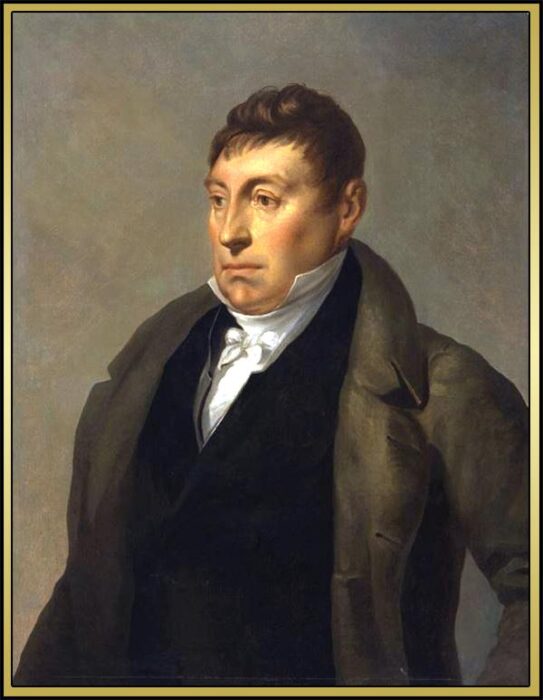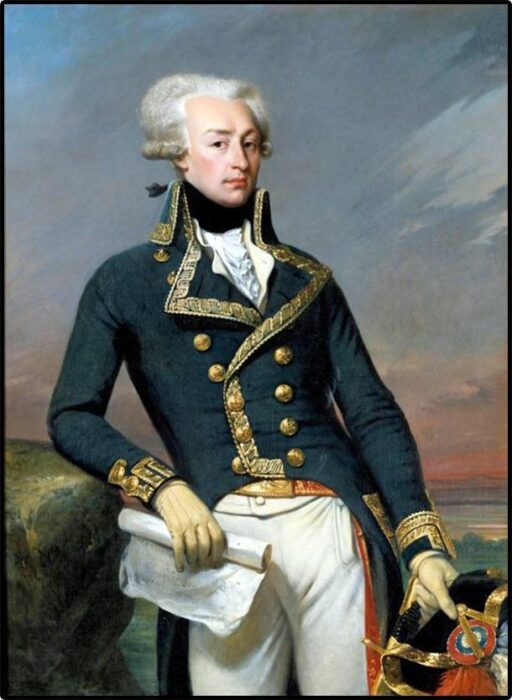Choose A Famous Visitor
1791 Thomas Jefferson & James Madison Visit
1797 John and Abigail Adams Visit Norwich
1824 Marquis de Lafayette Visits Norwich
1833 Andrew Jackson Visits Norwich
1848 Abe Lincoln’s 1st Visit to Norwich
1859 Millard Fillmore Visits Norwich
1860 Abe Lincoln’s 2nd Visit to Norwich
1870 Ulysses S. Grant Visits Norwich
1901 President Grover Cleveland Visits Norwich
1909 President Taft Visits Norwich
1936 Santa Claus Comes to Norwich
1948 Harry Truman Visits Norwich
1949 Frank Sinatra Opens Loews Poli Theater
1949 Bert Lahr Stars in "Burlesque"
1952 VP Candidate Richard Visits Norwich
1956 VP Richard Nixon Visits Norwich
1994 Bill Clinton Visits Norwich
1775 & 1776: George Washington Visits Norwich
The image depicts the day that George Washington assumed command of the American army on July 3,1775 in Cambridge Massachusetts. The image was created by Currier & Ives in 1876.
Four days earlier he and several members of his staff probably stayed in Norwich on the night of June 30, 1775. It is believed that he stayed in the first brick building built in Norwich, on the corner of (what was then), Main and Union Street. The public house, where he stayed, later became famous as an auction stand.
This was not the only occasion that General Washington visited Norwich. In April 13, 1776 he met and dined with Governor Jonathan Trumbull at General Jedediah Huntington’s home in Norwich. The next day Washington continued his trip, from Boston to New York, through New London.
Acknowledgements
“History of Norwich, Connecticut: From Its Possession From the Indians, to the Year 1866,” p 538, by Frances Manwaring Caulkins
“A Modern History of New London County, Connecticut, Volume II,” by Benjamin Tinkham Marshall (1872), p 533
The MET
1791: Thomas Jefferson & James Madison Visit Norwich
On May 21, 1791 the 3rd and 4th future Presidents of the United States, Thomas Jefferson and James Madison embarked on a month-long journey to New England and upstate New York, the object of which was not politics, as Hamiltonians and later historians assumed, but, in Madison’s words, “health, recreation and curiosity.” The trip is referred to as their “Botanizing Tour.” They were interested in learning more about the Hessian fly, a dreaded wheat pest.
The exact day of their trek through Norwich is unknown. Jefferson’s only journal entry referencing Connecticut describes his view of an 8-foot diameter water-wheel in Middletown.
“Northern Tour of 1791,” Monticello.org
Facebook: Photo was taken at a display at the Jefferson Monticello museum

1797: John & Abigail Adams Visit Norwich
The 2nd President of the United States, John Adams and his wife Abigail, stayed in Norwich on Wednesday, August 1, 1797.
On Wednesday evening, August 1, 1797, the Norwich Packet newspaper wrote that John Adams and lady arrived in town and that :
” The matross company came out to welcome them in full uniform, and fired a federal salute of I6 guns. They proceeded the next day to Providence, a large company on horseback attending them out of town.” The Adams stayed in a tavern/hotel kept by Jesse Brown that was renowned for its good dinners. The building located at 77 East Town Street, now houses the United and Community Family Services.
It is interesting to note that during the early part of the Revolutionary War, Jesse Brown was in the service of the State as confidential messenger and express agent.
FUN FACT: Abigail Adams and Barbara Bush are the only two women to be married to one United States President and the mother of another.
Acknowledgements
“History of Norwich, Connecticut: From Its Possession From the Indians, to the Year 1866,” p 513, by Frances Manwaring Caulkins
The Norwich Packet (Library of Congress)
“Old Houses of the Ancient Town of Norwich, 1600-1800”, 1895, p 365
by Mary Elizabeth Perkins
1824: Marquis de Lafayette Visits Norwich

1825 : Age 67
In 1824-1825, as part of a nationwide tour of the United States, Revolutionary War hero General Marquis de Lafayette passed through Connecticut, making stops in twenty-six towns along the route. Although fifty years had passed since the close of the Revolutionary War, 66 year-old Lafayette, the last surviving major general of the conflict, was still revered by Americans and was greeted by thousands of citizens hoping to get a glimpse of the beloved war hero as he traveled through the state. Most historians believe that America could not have won the war without the young French General’s help, yet many Americans today know little about him.
In the late afternoon of Sunday, August 22, 1824, a delegation of gentlemen from Norwich met the Marquis de Lafayette and his entourage in Montville. His escorts included his son Georges Washington de La Fayette, his secretary, and a committee from New York City. After they escorted him to Norwich, Lafayette received a booming National Salute in downtown and was greeted by an exuberant crowd.
When Lafayette and the delegation arrived outside the Kinney Hotel, (named for its proprietor, Newcomb Kinney, and later named the Merchants’ Hotel), Mayor Calvin Goddard gave a speech to the crowd welcoming their “Country’s Liberator.” He addressed the audience:
“General La Fayette:
In the name of the Mayor, Aldermen, and Common Council of the City of Norwich, and on behalf of all its citizens, I tender you their warmest congratulations upon your arrival among them.
The benevolent zeal for civil liberty which, in your juvenile days, brought you to this country, induced you to make so many sacrifices, and tended so much to awaken the sympathies and stimulate the exertions of the great nation to which you belong, to assist in achieving our independence, could only be adequately rewarded by this visit, to witness the blessings which we have derived from those sacrifices and exertions …”
Excerpt 1 from the NORWICH COURIER ON AUGUST 25, 1824
*Click on link to view original newspaper article
Lafayette then met with members of the crowd and was invited to dine with the city’s leadership. Many grateful Norwich citizens lingered outside the dining room and could be heard cheering from the street at different times throughout the meal. When the Marquis de Lafayette walked to the window several times during dinner and acknowledged the enthusiastic crowd, they roared with pleasure each time.
“During the repast, reiterated cheers were frequently ascending from the populace in the street; to each of these bursts of enthusiasm, the General arose and presented himself at the window, where the admiring multitude as often echo’d it.”
Excerpt 2 from the NORWICH COURIER ON AUGUST 25, 1824
Pages 2-3 of the September 1, 1864 edition of the Norwich Courier contain a more complete account of General Lafayette’s visit to the United States.

1792 : Age 35
Who Was General Marquis de Lafayette?
Marie-Joseph Paul Yves Roch Gilbert du Motier de La Fayette was known to Americans as the Marquis de Lafayette. He was born into a wealthy land-owning family in south-central France. Lafayette followed his family’s martial tradition and was commissioned a French officer at age 13. After being convinced that the American revolutionary cause was noble, he traveled to the New World seeking glory in it.
He was recruited by Silas Deane, a native of Groton, Connecticut, at the end of 1776. When the dashing 19-year-old Frenchman arrived in America in June of 1777 he was commissioned as a major general in the Continental Army. Lafayette was ultimately permitted to command Continental Army troops in the decisive Siege of Yorktown in 1781, the Revolutionary War’s final major battle that secured American independence.
During his time in the war, Lafayette forged many long-lasting relationships and earned the esteem of Americans across the colonies. Washington regarded Lafayette as one of his closest confidants and a surrogate son in almost every respect.
Upon the war’s end, Lafayette made trips between Europe and America and ultimately departed for France in 1785, where he remained for almost 40 years. These years were particularly difficult for Lafayette as he became a political prisoner of the French Revolution but was ultimately released by Napoleon.
Acknowledgements
The Norwich Courier, 08/25/1824
The Norwich Courier, 09/01/1824
“Marquis de Lafayette” 1825, by Matthew Harris Jouett
“Portrait of Gilbert du Montier, Marquis de Lafayette, 1792,” 1792, by Joseph Desire Court
A more extensive list of sources may be found by clicking the “Bibliography” button, and, then entering “Marquis” in the SEARCH box.
1833: Andrew Jackson Visits Norwich
During the summer of 1833 the 7th President of the United States Andrew Jackson decided to tour a portion of the Eastern states. Accompanying him would be the Vice President Martin Van Buren and several other dignitaries. Martin Van Buren later became the 8th President of the United States.
About that same time, many citizens in Norwich had been anxious to erect some sort of memorial of respect for the Mohegan Sachem, Uncas. As word reached Norwich regarding the president’s tour, residents decided to make an effort to connect President Jackson’s travel plan with a ceremony featuring the president laying the cornerstone of a monument honoring Uncas.
On June 24, 1833 the presidential party came from Hartford by land, arriving by the Essex Turnpike in open coaches, guided by a colorful and brilliant escort of cavalry that had left Norwich to meet the party. At the cemetery they were greeted by a large segment of local citizens, more than one military company, groups of children with appropriate banners and a number of Mohegan Indians.
President Jackson moved the foundation-stone into its place. One reporter later wrote that it was “a token of respect from the modern warrior to the ancient warrior.” (Uncas had died some 149 years previously, in 1684).
The granite column seen on the site today was dedicated in 1842.
Acknowledgements
“From One Warrior to Another,” 04/16/2018, by Richard Curland
Bureau of Engraving and Printing
1848: Abraham Lincoln's 1st Visit to Norwich
On September 11, 1848, Congressman Abraham Lincoln arrived at Norwich after taking a steam ship from New York City. He was destined for Massachusetts to help rally that state’s Whigs behind the presidential candidacy of Zachary Taylor
He gave no known speeches in Connecticut. After his visit to Norwich, he took the railroad north to Worcester, where the Bay State Whigs were holding a convention. Taylor won the election and became the 12th President of the United States in 1849.
It was Mr. Lincoln’s first visit to Connecticut, and he would not return for more than 11 years. Abraham Lincoln became the 16th President of the United States in 1861.
Acknowledgements
“Norwich Hosted Campaign Speech by Abraham Lincoln,” 01/07/2018, by Richard Curland
Library of Congress
1859: Millard Fillmore Visits Norwich
Millard Fillmore served as the 13th President of the United States, July 1850-March 1853. On September 7, 1859 he was a guest of honor for Norwich’s 200th Jubilee, and marched in the celebration’s procession from Franklin Square to Chelsea Parade. He was invited to the event by his cousin, Reverend Comfort Day Fillmore, who was one of the Vice-Presidents of the 200th Jubilee.
Millard and Comfort Day shared the same great-grandfather John Fillmore. John’s sons, Lieutenant Nathaniel and Comfort were both born and grew up in West Farms (modern-day Franklin). The two grandfathers, Lt. Nathaniel and Comfort, left Franklin after they bought a large farm in Vermont.
Unfortunately, they bought the farm from an unscrupulous individual, and were left penniless. Millard was born into poverty but rose to success by diligent study and hard work. He became a successful attorney and then became a politician.
He was a member of the Whig political party, and was the last President of the United States who was not a Republican or Democrat.
Acknowledgements
“The Norwich Jubilee, A Report of the Jubilee at Norwich, Connecticut on the 200th Anniversary of the Settlement of the Town,”1859, by John W. Stedman
Portrait by George P.A. Healy
A more extensive list of sources may be found by clicking the “Bibliography” button, and, then entering “Fillmore” in the SEARCH box.
1860: Abraham Lincoln's 2nd Visit to Norwich
It is said that Abraham Lincoln spent the night of March 9, 1860 in Norwich. After freshening up at the Wauregan House, he was off to City Hall on Jail Hill. He was in Norwich on the campaign trail for himself and his good friend Gov. William A. Buckingham.
It’s widely accepted among historians that his speeches in Norwich in March 1860 helped him clinch the 1860 Republican presidential nomination.
The Norwich Bulletin wrote that City Hall was packed on March 9, 1860, and that “Mr. Lincoln was received upon his entrance into the hall with storms of applause, loud and prolonged, and when he was introduced by Mr. Lamb, the enthusiasm of the audience knew no bounds. Some minutes elapsed before the applause subsided sufficiently to allow him to commence his address.”
Acknowledgements
“Norwich Prepares to Celebrated Historic Visit by Lincoln,” 03/09/2010, by Michael Gannon
Portrait by George P.A. Healy
1870: Ulysses S. Grant Visits Norwich
Ulysses S. Grant was the 18th President of the United States. He served as President from 1869-1877. In 1870, early in his term as President, he visited Norwich. The Walk Norwich Trails website states :
“The couple (William A. Buckingham and his wife Eliza) entertained Ulysses S. Grant here on his visit to Norwich in 1870.” (Info Source 1).
According to the Norwich Bulletin, he was hosted by the Wauregan Hotel. In 1870 The Wauregan was touted as the finest hotel between New York and Boston. (Info Source 2)
Acknowledgements
Walk Norwich Trails
“Welcome Back to the Wauregan in Norwich,” 12/20/2007, by Joan Gordon
Courtesy of the Brady-Handy Photograph Collection, Library of Congress
1901: President Grover Cleveland
Guest of Honor For Old Home Week
On September 1-7, 1901 Norwich celebrated “Old Home Week“. It was a grand affair the featured the 22nd President of the United States, Grover Cleveland as the guest of honor. President Cleveland had never been to Norwich, however, his father Reverend Richard Cleveland, and his grandfather, Deacon William Cleveland was born there. The image shows a horse drawn carriage carrying former President Grover Cleveland in Norwich.
The concept of Old Home Week originated in New Hampshire. The idea was to encourage former sons and daughters of the state to pay a return visit so they could have fellowship with their friends and neighbors who had remained. The idea quickly spread throughout New England and by 1901 the city of Norwich was ready to join the movement.
Former President Cleveland’s had roots in Norwich that ran deep, and, he was eager to explore them. His grandfather, Deacon William Cleveland, lived and worked in Norwich for most of his life. Deacon Cleveland was a silversmith, watch and a clockmaker who lived on a farm on Bean Hill. He owned and operated a jewelry shop that manufactured silver spoons, watches, and regular and musical clocks. His shop was the located across the street from the Methodist Episcopal Church, which later became the Adams Tavern, (192 W. Town Street).
Upon his arrival in Norwich on Wednesday, September 4, 1901 President Cleveland was driven in former Norwich Mayor Frederic Osgood’s three-seated brake car to Cleveland’s grandfather’s old shop on Bean Hill. Afterwards, he was escorted to Norwichtown green, where an exhibit, containing artifacts from his grandfather and other Norwich artisans, had been created.
Acknowledgements
Bulletin Print, p 6, 1901
Darlene’s Family Genealogy
Bulletin Print, p 34, 1901
Portrait by Napoleon Sarony
A more extensive list of sources may be found by clicking the “Bibliography” button, and, then entering “Grover” in the SEARCH box.